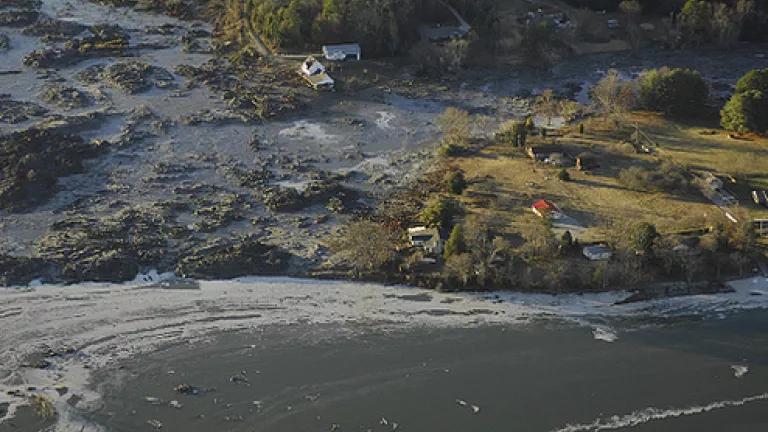Remembering Kingston: Why the Obama Administration Must Regulate Coal Ash and Rein in TVA

It was the nightmare before Christmas.
On Dec. 22, 2008, the stockings were hung by the chimney with care, but homeowners sleeping snugly along the banks of the Emory River received far worse than a lump of coal. Residents of Harriman, Tennessee bore the brunt of a wall of toxic coal waste, which sprang from a leaking storage impoundment adjacent to the Kingston Fossil Plant, operated by the Tennessee Valley Authority. This massive spill at the TVA power plant near Knoxville dumped more than a billion tons of toxic coal ash and buried more than 300 acres of homes and farmland in thick gray sludge.
The incident ranks as the largest coal ash disaster in American history -- and was 100 times worse than the infamous Exxon-Valdez oil spill in Alaska 20 years ago.
The Kingston catastrophe revealed the dirty lilttle secret that there are no federal rules setting standards for the safe disposal of ash or limiting the discharge of toxic leachate into our waterways. In the wake of the sludge spill, the U.S. Environmental Protection Agency announced that it will propose regulations for disposal of coal ash by the end of this year.
(The 1.1 billion gallon coal sludge spill in Tennessee is costing TVA an estimated $1 million per day to clean up.)
As everyone waits for EPA to act, the anniversary of the coal ash disaster in Tennessee looms. New EPA and TVA data from the spill, analyzed by the Environmental Integrity Project, reveal that coal ash that coated the community contains an estimated 140,000 pounds of arsenic -- more than twice the reported amount of the toxin discharged into U.S. waterways from all U.S. power plants in 2007.
Data also show that the Kingston ash spill deposited nearly 320 tons of vanadium in the Emory River, or more than seven times the total discharge of this radioactive pollutant from all power plants in 2007. The Kingston facility singlehandedly discharged more than of chromium, lead, manganese, and nickel into the Emory River last year than reported discharges of those pollutants from the entire U.S. power industry in 2007.
The EIP analysis of the new data finds a total of 2.66 million pounds of 10 toxic pollutants – arsenic, barium, chromium, copper, lead, manganese, mercury, nickel, vanadium and zinc. That compares to the much lower 2.04 million pounds of such discharges from all U.S. power plants into surface waters in 2007. The 2.66 million pound of toxic pollutants dumped into the Emory River in 2008 is nearly 45 times higher than the 59,950 pounds of such materials the TVA reported that released into all U.S. waterways in 2007. (Click here to see a detailed chart comparing the TVA versus all U.S. power plant toxic pollution levels.)
"Now that EPA is expected to finally propose standards for ash disposal sites by the end of this month," says EIP Director Eric Schaeffer, "let’s hope these overdue regulations lead to the shutdown of unsafe and outdated ash ponds like the one that burst its banks in Tennessee one year ago."
Indeed, EPA must swiftly fulfill its pledge to issue regulations that will at long last protect Americans from hazardous coal combustion waste. You can help by urging the agency to act quickly.
In addition, NRDC -- in a coalition led by EIP -- also is seeking to hold TVA more accountable to federal environmental laws and to restore EPA's authority to enforce environmental laws against the federally owned utility. The coalition is calling on the White House and Congressional leaders to end TVA’s special protections from environmental enforcement actions, environmental penalties and competition in the TVA region. In addition, the groups are requesting that the Obama administration seek to address TVA's environmental problems by appointing nominess to TVA's board who will transform this federal utility into a leader in advancing clean energy resources and sustainable resource management.
